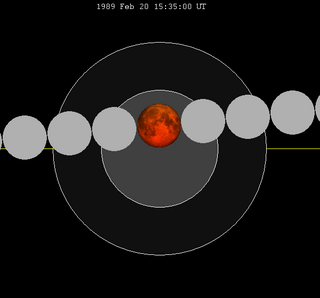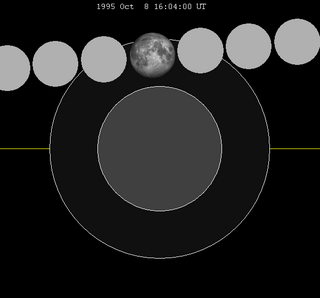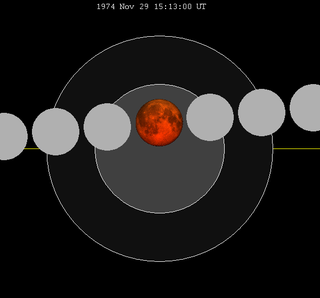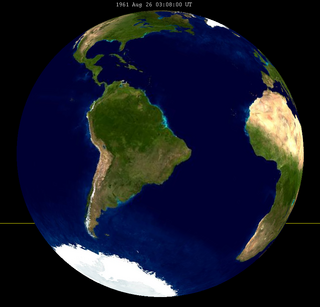
A total lunar eclipse took place on Monday, February 20, 1989, the first of two total lunar eclipses in 1989.

A total lunar eclipse took place at the Moon's descending node of the orbit on Tuesday, September 16, 1997, the second of two lunar eclipses in 1997. A shallow total eclipse saw the Moon in relative darkness for 1 hour, 1 minute and 30.8 seconds. The Moon was 19.094% of its diameter into the Earth's umbral shadow, and should have been significantly darkened. The partial eclipse lasted for 3 hours, 16 minutes and 28.2 seconds in total. The penumbral eclipse lasted for 5 hours, 8 minutes and 20.1 seconds. The partial eclipse lasted for 3 hours, 16 minutes and 28.2 seconds. The total eclipse lasted for 1 hour, 1 minute and 30.8 seconds. Maximum eclipse was at 18:46:39.1 UTC. The moon's apparent diameter was extremely large because occurred only 3 hours and 21 minutes past perigee. The Moon was only 356,986 km of the Earth at greatest eclipse.

A partial lunar eclipse took place on Wednesday, July 28, 1999, the second of two lunar eclipses in 1999.

A total lunar eclipse will take place between Monday and Tuesday, June 25-26, 2029. A central total eclipse lasting 1 hour and 41 minutes 53 seconds will plunge the full Moon into deep darkness, as it passes right through the centre of the Earth's umbral shadow. While the visual effect of a total eclipse is variable, the Moon may be stained a deep orange or red color at maximum eclipse. It will be able to be seen from most of the Americas, Western Europe and Africa. The partial eclipse will last for 3 hours and 39 minutes 32 seconds in total.

A total lunar eclipse took place on Friday, June 4, 1993, the first of two total lunar eclipses in 1993, the second being on Monday, November 29. The Moon was plunged into darkness for 1 hour and 36 minutes, in a deep total eclipse which saw the Moon 56% of its diameter inside the Earth's umbral shadow. The visual effect of this depends on the state of the Earth's atmosphere, but the Moon may have been stained a deep red colour. The partial eclipse lasted for 3 hours and 38 minutes in total. The moon passed through the center of the Earth's shadow.

A penumbral lunar eclipse took place on Sunday, October 8, 1995, the second of two lunar eclipses in 1995, the first was a partial lunar eclipse on Saturday, April 15.
A total lunar eclipse took place on Monday, October 28, 1985, the second of two total lunar eclipses in 1985, the first being on May 4, 1985.
A partial lunar eclipse took place on Saturday, August 27, 1988, the second of two lunar eclipses in 1988, the first being on March 3, 1988. The Earth's shadow on the moon was clearly visible in this eclipse, with 29.159% of the Moon in shadow; the partial eclipse lasted for 1 hour, 52 minutes and 59.7 seconds. The Moon was only 5 hours and 48 minutes before perigee, making it 6.3% larger than average

A partial lunar eclipse took place on Monday, June 15, 1992, the first of two lunar eclipses in 1992, the second being with a total lunar eclipse on Wednesday, December 9.

A penumbral lunar eclipse took place on Friday, July 26, 1991, the third of four lunar eclipses in 1991. This was the 2nd member of Lunar Saros 148. The previous event was on 15 July 1973, and the 1st eclipse of the series. The next event was on 6 August 2009.

A penumbral lunar eclipse took place on Wednesday, January 30, 1991, the first of four lunar eclipses in 1991.

A total lunar eclipse took place on Friday, November 29, 1974, the second of two lunar eclipses in 1974.
A total lunar eclipse took place on Thursday, September 6, 1979, the second of two lunar eclipses in 1979. A shallow total eclipse saw the Moon in relative darkness for 44 minutes and 24.7 seconds. The Moon was 9.358% of its diameter into the Earth's umbral shadow, and should have been significantly darkened. The partial eclipse lasted for 3 hours, 11 minutes and 54.1 seconds in total.

A total lunar eclipse took place on Monday, May 13, 1957, the third of fourteen total lunar eclipses of Lunar Saros 130. The Moon was plunged into darkness for 1 hour and 18 minutes, in a deep total eclipse which saw the Moon 30% of its diameter inside the Earth's umbral shadow. The visual effect of this depends on the state of the Earth's atmosphere, but the Moon may have been stained a deep red colour. The partial eclipse lasted for 3 hours and 32 minutes in total.
A total lunar eclipse took place on Friday, April 22, 1921. This was the first total lunar eclipse of Saros cycle 130. A shallow total eclipse saw the Moon in relative darkness for 40 minutes and 6 seconds. The Moon was approximately 7% of its diameter into the Earth's umbral shadow, and should have been significantly darkened. The partial eclipse lasted for 3 hours and 22 minutes in total.
A partial lunar eclipse took place on Sunday, April 12, 1903. This nearly total lunar eclipse of Saros cycle 130 preceded the first total eclipse on April 22, 1921. The Moon was almost covered by the Earth's shadow in a very deep partial eclipse, which lasted 3 hours and 17 minutes. With 96.77% of the Moon in shadow at maximum eclipse, this was quite a memorable event.
A total lunar eclipse took place on Tuesday, November 18, 1975, the second of two total lunar eclipses in 1975. A shallow total eclipse saw the Moon in relative darkness for 40 minutes and 11.1 seconds. The Moon was 6.421% of its diameter into the Earth's umbral shadow, and should have been significantly darkened. The partial eclipse lasted for 3 hours, 29 minutes and 2.1 seconds in total. Occurring only 4.9 days after apogee, the Moon's apparent diameter was 4% smaller than average.

A total lunar eclipse took place on Wednesday, October 18, 1967, the second of two total lunar eclipses in 1967, the first being on April 24, 1967.

A partial lunar eclipse took place on Thursday, May 24, 1956. It was the first eclipse of the last partial set in Saros series 120.

A partial lunar eclipse took place on July 16, 1954.




































